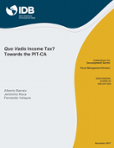Quo Vadis Income Tax?: Towards the PIT-CA
Date
Nov 2017
The income tax system has prevailed for more than 200 years. Its capacity to adapt to cultural, economic, political, and social change has made it the greatest raiser of revenue in human history. The 2008 financial crisis and its consequent fiscal crises brought about fundamental administrative changes, notably a greater impulse toward tax transparency. Those changes offer a challenge and an opportunity for the modification of income tax’s design. Financial systems in the developed countries, which needed huge bailouts in a context of widespread insecurity (intervention in banks and insurance companies, plunges in stock markets), ran the risk of losing the competitive advantages stemming from their institutional and regulatory stability. Sovereign debt thus grew dizzyingly as fiscal stimulus initiatives sought to recapitalize capital markets, matched by mounting social disquiet about high unemployment and the acceleration of income concentration. Thus, there was a convergence of interests among States and civil society to put an end to tax opacity. International cooperation commitments on automatic information exchange, more precise determination of business profits in each of the countries involved in the base erosion and profit shifting (BEPS) project, and knowledge of the beneficial owner, not only help curb tax evasion and avoidance but also make possible changes in tax policy. This study proposes a new form of income tax based on such administrative changes. It suggests a comprehensive personal income tax that covers all of a taxpayer’s worldwide income on an accrual basis (PIT-CA), with the corporate income tax that complements it in its functions as a policy instrument, tax control, and revenue advance (withholding) of the PIT-CA itself. The proposed tax covers a taxpayer’s entire global income, without exception, which is levied on an accrual basis and is fully integrated with corporate income tax. An individual’s final tax treatment will be that of the taxpayer’s country of residence, and therefore any moves designed to secure a lower tax at source will serve little. In our view, this architecture will make it possible to boost the tax’s revenue, efficiency, equity, simplicity, and “coordinability” relative to current models. There is no doubt that the structure of income tax must be modernized in the new circumstances, and this study seeks to contribute to that process.




